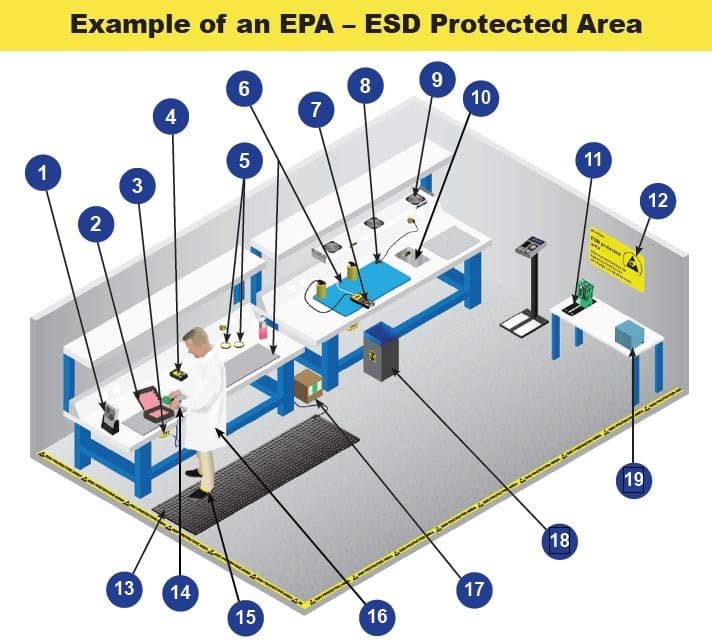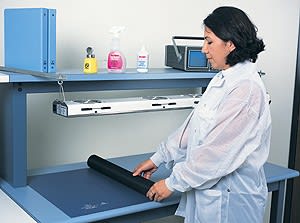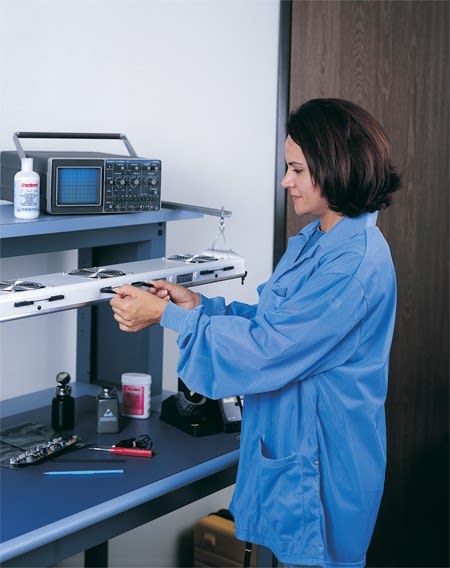The Need for ESD Control - An introduction to the principles of ESD Control
Follow articleHow do you feel about this article? Help us to provide better content for you.
Thank you! Your feedback has been received.
There was a problem submitting your feedback, please try again later.
What do you think of this article?
Electronic Device Electrostatic Discharge Sensitivity
Many electronic components and assemblies used in high technology products can be damaged or degraded by the sudden exchange of static electrical charges. This release of stored energy is called ElectroStatic Discharge or ESD.
Components such as transistors, diodes, laser diodes, electro-optical devices, precision film resistors and a variety of integrated circuits are all sensitive to ElectroStatic Discharge, and as electronics manufacturers drive to miniaturise devices and improve operating speeds, susceptibility of devices to ESD is increasing. Devices are subject to ESD damage at every stage of production: from wafer fabrication to populated circuit boards in sub-assemblies and assemblies.
Introducing ESD Control to Your Business
Industry experts have estimated that electronics product losses caused by electrostatic discharge range from 8% to 33%. However, introducing a carefully-managed ESD Control Programme can drastically reduce product rework and improve reliability, resulting in lower costs of returned items and lower warranty costs.
Charleswater recommend that firms involved in electronics design and production set up ESD Protected Areas or EPA’s, workstations where fundamental ESD control principles can be observed, reducing ESD events and preventing the damage they cause.
The diagram below shows a typical ESD-Protected workstation – by clicking on the links, you can see suitable ESD control products to help prevent ESD:
| 1. | Bench Top Ionisers | 11. | PCB Storage |
| 2. | Packaging Containers | 12. | Signs and Labels |
| 3. | Earth Bonding Point Bars | 13. | Floor Mats |
| 4. | Testers und Monitors | 14. | Wrist Straps |
| 5. | ESD Tape | 15. | Foot Grounders |
| 6. | Worksurface Mats | 16. | Lab Coats |
| 7. | Surface Resistance Meters | 17. | Floor Maintenance |
| 8. | Ground Cords | 18. | Waste Bins and Liners |
| 9. | Overhead Ionisers | 19. | Document Handling |
| 10. | Shielding Bags |
ESD Control and ESD-safe workstations are based on four key principles:
Grounding: seated operators should be grounded using a wrist strap, or a flooring/footwear system is an alternative form personnel ground for standing or mobile workers. Foot grounders or other types of ESD footwear are worn while standing or walking on an ESD floor. (ESD footwear must be worn on both feet). Personnel grounding devices must be tested at least twice daily whilst being worn.
ESD worksurfaces, such as mats (shown below), are an integral part of the workstation, particularly in areas where hand assembly occurs.
Charleswater recommend the following ESD safe matting available from RS:
- Statfree DLR™ Rubber Bench Mat (738-9757)
- Statfree DLR™ Rubber Bench Roll (738-9751)
Removing Insulators: materials that do not easily transfer electrons are called insulators. These include common plastics and glass. Insulators typically hold charge and cannot be easily grounded to conduct the charge away. It is important that all non-essential insulators are removed from the ESD protective workstation, otherwise, any investment in an ESD working surface may be wasted. The biggest threat is Field Induced Discharges, which can occur even at a properly grounded workstation. If an ESDS is grounded in the presence of an ElectroStatic charge, the ESDS may become charged with a voltage induced on it, rather than having charges removed from it. When placed on the grounded ESD working surface, a discharge occurs. Ideally all insulators should be removed from the EPA. Alternatives include switching to an ESD protective version of the same product, or to coat periodically with topical antistat. If the insulator is essential and has to stay, is essential to the process, the only ESD control tool which can neutralise charges is an ioniser.
Ionisation: reduction of charges on insulators occurs naturally by a process called neutralisation. Ions are charged particles that are normally present in the air – as opposite charges attract, charges will be slowly neutralised over time. Ionisers create great numbers of positively and negatively charged ions. Fans help the ions flow over the work area, meaning that ionisers can neutralise static charges on an insulator in a matter of seconds. Picture shows a typical ioniser in operation.
Charleswater recommend the following Ionisers available from RS:
- Fan Bench Top Ioniser (684-2920)
- Fan Overhead Ioniser (684-2942)
- Ionising Air Gun (798-9262)
Shielding: the final fundamental principle of ESD control is to package ESD sensitive components and assemblies during storage or transportation outside the EPA in packaging with ESD shielding properties. A Faraday Cage effect can protect ESDS contents in a shielding bag, or another container with a shielding layer. To complete the enclosure, lids must be placed on boxes or containers and shielding bags closed properly – packaging with holes, tears or gaps must not be used.
Charleswater recommend the following ESD packaging available from RS:
- ESD Shielding Bag without Zip (182-8792)
- ESD Shielding Bag with Zip (431-9544)




